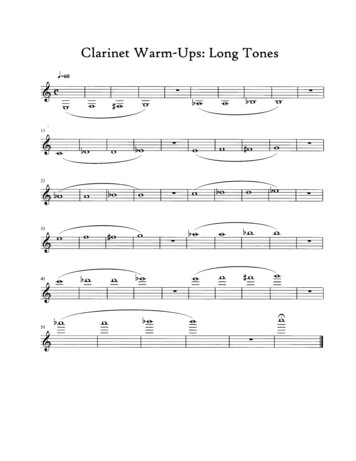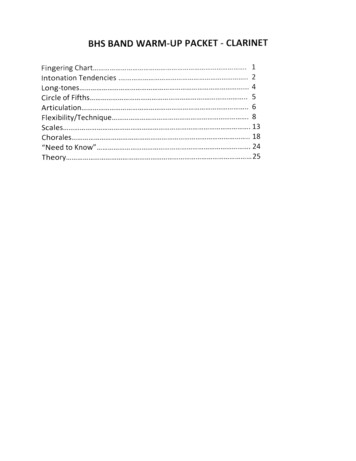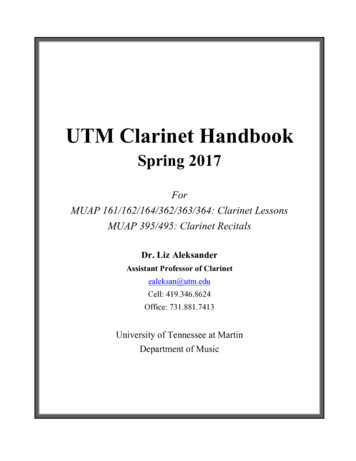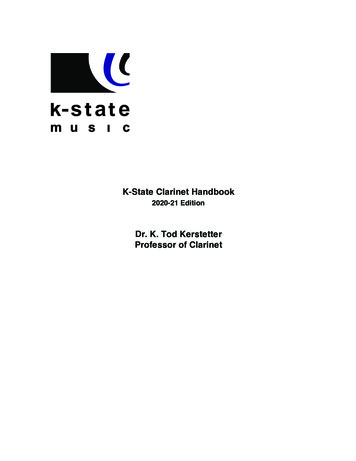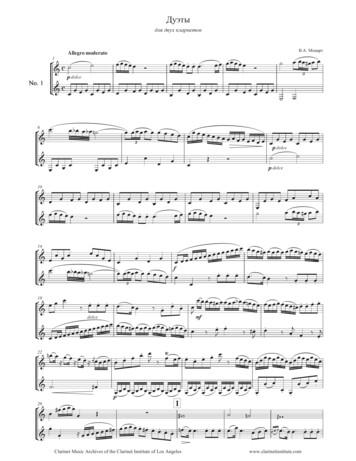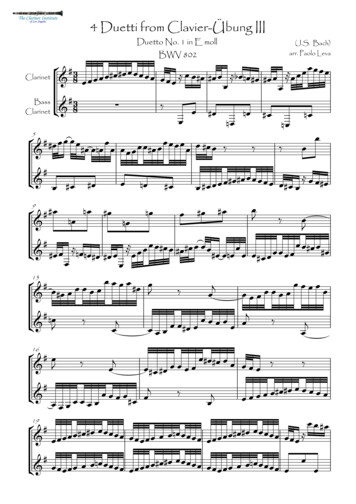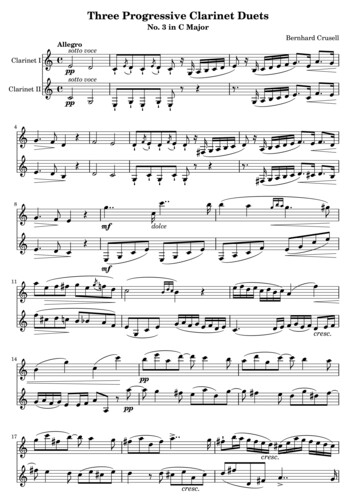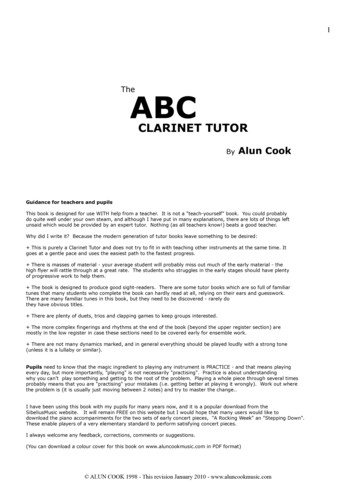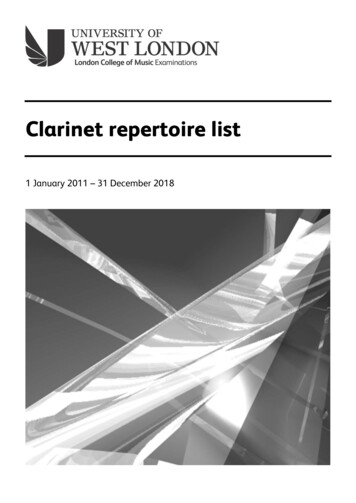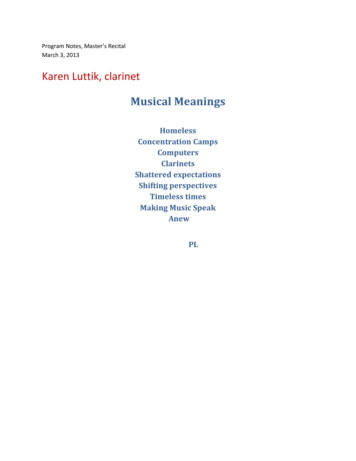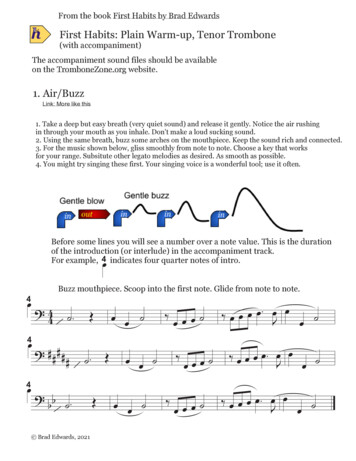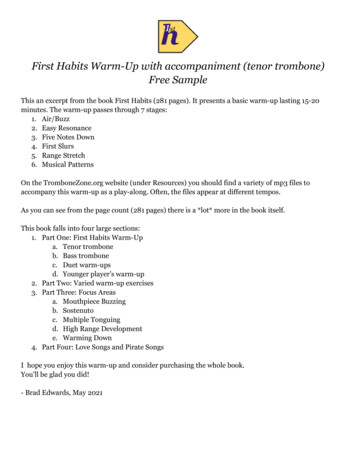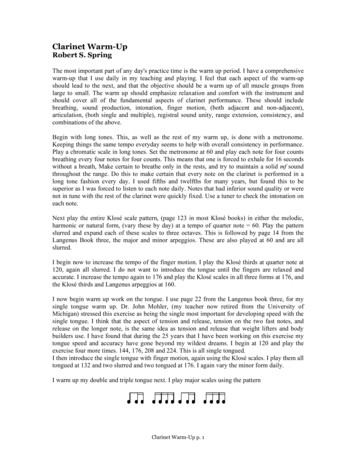
Transcription
Clarinet Warm-UpRobert S. SpringThe most important part of any day's practice time is the warm up period. I have a comprehensivewarm-up that I use daily in my teaching and playing. I feel that each aspect of the warm-upshould lead to the next, and that the objective should be a warm up of all muscle groups fromlarge to small. The warm up should emphasize relaxation and comfort with the instrument andshould cover all of the fundamental aspects of clarinet performance. These should includebreathing, sound production, intonation, finger motion, (both adjacent and non-adjacent),articulation, (both single and multiple), registral sound unity, range extension, consistency, andcombinations of the above.Begin with long tones. This, as well as the rest of my warm up, is done with a metronome.Keeping things the same tempo everyday seems to help with overall consistency in performance.Play a chromatic scale in long tones. Set the metronome at 60 and play each note for four countsbreathing every four notes for four counts. This means that one is forced to exhale for 16 secondswithout a breath, Make certain to breathe only in the rests, and try to maintain a solid mf soundthroughout the range. Do this to make certain that every note on the clarinet is performed in along tone fashion every day. I used fifths and twelfths for many years, but found this to besuperior as I was forced to listen to each note daily. Notes that had inferior sound quality or werenot in tune with the rest of the clarinet were quickly fixed. Use a tuner to check the intonation oneach note.Next play the entire Klosé scale pattern, (page 123 in most Klosé books) in either the melodic,harmonic or natural form, (vary these by day) at a tempo of quarter note 60. Play the patternslurred and expand each of these scales to three octaves. This is followed by page 14 from theLangenus Book three, the major and minor arpeggios. These are also played at 60 and are allslurred.I begin now to increase the tempo of the finger motion. I play the Klosé thirds at quarter note at120, again all slurred. I do not want to introduce the tongue until the fingers are relaxed andaccurate. I increase the tempo again to 176 and play the Klosé scales in all three forms at 176, andthe Klosé thirds and Langenus arpeggios at 160.I now begin warm up work on the tongue. I use page 22 from the Langenus book three, for mysingle tongue warm up. Dr. John Mohler, (my teacher now retired from the University ofMichigan) stressed this exercise as being the single most important for developing speed with thesingle tongue. I think that the aspect of tension and release, tension on the two fast notes, andrelease on the longer note, is the same idea as tension and release that weight lifters and bodybuilders use. I have found that during the 25 years that I have been working on this exercise mytongue speed and accuracy have gone beyond my wildest dreams. I begin at 120 and play theexercise four more times. 144, 176, 208 and 224. This is all single tongued.I then introduce the single tongue with finger motion, again using the Klosé scales. I play them alltongued at 132 and two slurred and two tongued at 176. I again vary the minor form daily.I warm up my double and triple tongue next. I play major scales using the patternClarinet Warm-Up p. 1
I play them at 120, 144, 176, 208, 240, and 288. I follow this with scales triple tongued in thefollowing pattern - two octaves and one note in range.This is played at 160, 192, 224, 264, and 320. Last I do some circular breathing studies usingagain the Klosé scales pattern.The entire warm up takes about 45 minutes to one hour if I do not have any reed work to do. Iusually practice music on which I am working for another 30-45 minutes following. As I said, Ithink that everything in the warm up leads one to the next, and that every part of the clarinetist iswarmed up. I also feel that it prevents some of the problems that many performers have withmuscles, tendons and other performer related physical problems. I know that this is prettyextensive, but I find that I am not at a loss for technique when it's necessary. The long tones andslow playing help in sound stabilization, control, and endurance.I do not vary the warm up on performance days, I do not warm up differently for different typesof performances, nor do I use a special warm up for contemporary music. I feel that if theperformer is approaching contemporary music in a different manner than "traditional" music, theclarinetist is probably playing the clarinet in the wrong fashion. The length of the warm up stayspretty much the same. If I do have less time I might leave out the circular breathing for a day.This very rarely occurs.I hope this routine proves to be helpful to others. I have been teaching this type of warm up forabout ten years. I really believe that we need to be teaching the comprehensive clarinetist andmaking our students aware that the physical aspects of performing the clarinet are every bit asdemanding as those of the brass player.As you can see, I feel very strongly about this aspect of clarinet performance. If I teach this tostudents, I find that they are "teaching themselves" so much more than if I do not insist on acomprehensive warm up. After all, they are their own teachers most of the time.Robert S. Spring, DMAProfessor of Music, Arizona State UniversityCopyright 1995 Spring, Robert S. All Rights ReservedProvided by Katherine KellertFreelance Musician and teacher(240) 432-7872Clarinet Warm-Up p. 2
Clarinet Warm-Up p. 3
Klose Scales p. 123Clarinet Warm-Up p. 4
Langenus Arpeggios p. 14Clarinet Warm-Up p. 5
Clarinet Warm-Up p. 6
Clarinet Warm-Up p. 7
Langenus p. 22Clarinet Warm-Up p. 8
Clarinet Warm-Up Robert S. Spring The most important part of any day's practice time is the warm up period. I have a comprehensive warm-up that I use daily in my teaching and playing. I feel that each aspect of the warm-up should lead to the next, and that the objective should be a warm up of all muscle groups from large to small. The warm up should emphasize relaxation and comfort with the instrument
